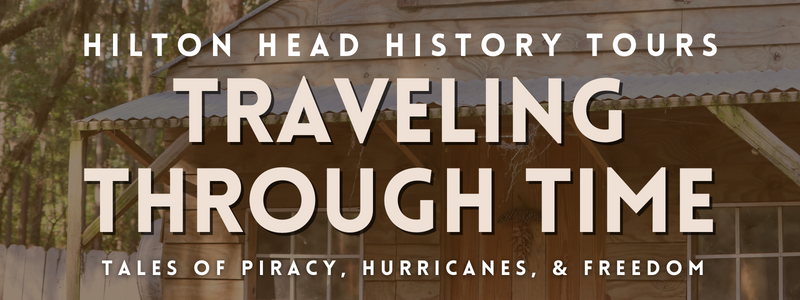Written in partnership with Hilton Head History Tours and published in the Fall/Winter 2022 Palmera Compass Magazine
It was as if I was hearing of Hilton Head Island for the very first time. We have come to Green’s Shell Park to see a “Shell Ring” built over 3,000 years ago by Nomadic Indigenous people who traveled here in search of shellfish. But there is more history here than just the ring. There, on the observation deck overlooking Skull Creek, the 12-mile-long island that we know—or thought we knew—suddenly becomes a pirate’s hideaway right before our very eyes.

“Crews would use Skull Creek for careening their ships in order to clean the hulls, which was essential in making sure that the vessel’s speed wasn’t impaired.” This is Todd, the guide responsible for reintroducing our beloved island to all of us during today’s Hilton Head History Tour. Passionate about the region’s past, Todd tells of Hilton Head’s involvement during the Golden Age of Piracy. A perfect place for hiding and repairing their ships, crews could also navigate the intracoastal waterway between the key ports of Savannah and Charleston.
“A journal entry from the time describes up to 8 pirate ships out there careening their hulls”. He motions to the waterway behind us, making the group turn to take in the current scene of a single sailboat gliding through the calm creek framed by spartina grass. It’s hard to understand, but this won’t be the only time we’re tasked with imagining how the island would have looked hundreds of years ago during the tour.
Tales of Blackbeard follow, and the curtain of Hollywood’s take on piracy falls. Our eyes grow wide when Todd suggests the idea of Blackbeard’s treasure being buried somewhere at the south end of the island, or in Bath, NC, but probably lost forever with the changing sea levels.
As the tour moves on, we jump back and forth in time with every new significant location we explore. We make a brief journey through the Antebellum Period as we circle the main house of Honey Horn Plantation, what is now the home of the Coastal Discovery Museum, a Smithsonian affiliate. Todd assures us that a return trip back to the museum on our own time is worth it, even if it’s just to walk through the beautiful butterfly enclosure.
We cross into the devastating stretch of time immediately after a deadly hurricane in 1893 wreaks havoc on Hilton Head and leaves most of the island essentially uninhabitable for over a year. We’re standing in front of one of four surviving buildings at Honey Horn, and after our bus travels toward the middle of the island, we find the second building looming over us in Zion Cemetery—the Baynard Mausoleum.
I’ve heard about this tomb before, specifically a ghost story that the locals like to tell. It’s easy to see why this structure survived a massive hurricane when so many other buildings were flattened. This structure is unlike anything in our area. The roof stone is made of Pennsylvania blue slate and the walls are stone cut in Maryland. The stone cutters who carved it from the mountain traveled with it here on a series of barges and after its final leg up the Broad Creek, it was assembled where it still sits today.
We’re leaving Zion Cemetery with the mystery of the vanishing Chapel of Ease on our hands and stories of the local patriots in the Bloody Legion’s guerrilla attacks during the Revolutionary War swirling through our heads. Our group is absorbing the information and stories as fast as we can, and no, we don’t seem to have many questions since Todd is so thorough with his explanations. Although, he compels us to pepper him with questions throughout the tour. It’s as if we’re gradually putting together the pieces of Hilton Head’s history in some sort of puzzle, and the last pieces are lying in Mitchelville—at least for our tour’s sake.


A street lined with colorful beach bungalows gives way to the entrance of Mitchelville, the first town built by and for formerly enslaved people. Metaphorically called the Port Royal Experiment at the time, the group of escaped slaves that had become contraband of war before Emancipation ultimately proved their ability to self-govern. Mitchelville was a success, and by the war’s end had almost twice as many inhabitants as Gettysburg, Pennsylvania at the time.
Its importance rediscovered relatively recently, Mitchelville and other island landmarks show us that there is so much still to learn about our island. A theme reoccurring during the entirety of the tour, more of Hilton Head’s history is still being discovered. This is reason enough to argue that only taking a Hilton Head History Tour once isn’t enough. With so much information packed into three hours, each tour taken is already bound to be considerably different, and who knows what historians will discover by the time you return to Hilton Head for your next vacation.
Make your reservation, lace up your sneakers, and get ready to learn the real story behind Hilton Head Island.




